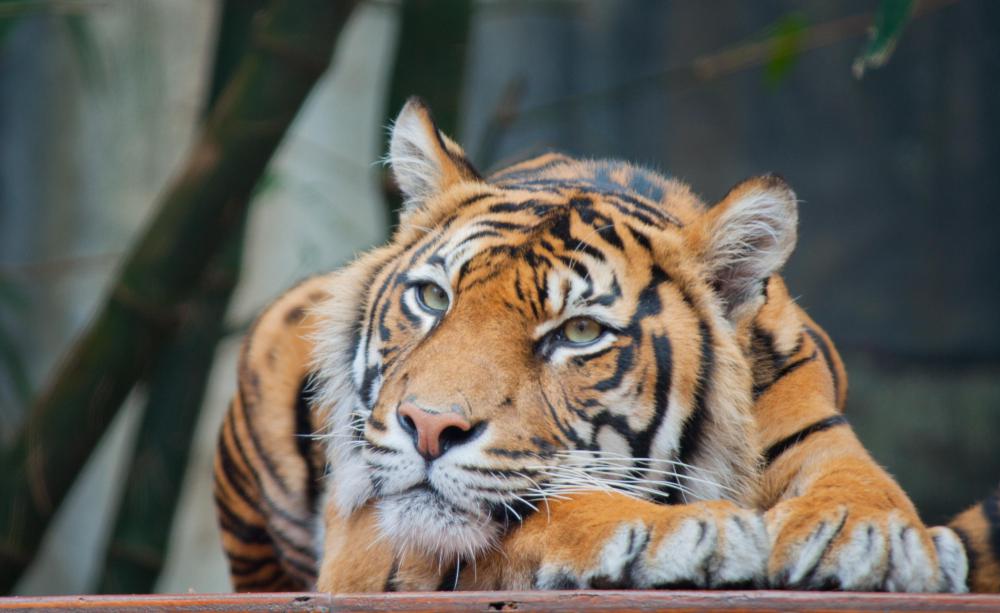At AllThingsNature, we're committed to delivering accurate, trustworthy information. Our expert-authored content is rigorously fact-checked and sourced from credible authorities. Discover how we uphold the highest standards in providing you with reliable knowledge.
What Is a Bengal Tiger?
The Bengal tiger, or Panthera tigris tigris, is a species that originated in India, Nepal, and Bangladesh. This particular species of tiger is currently endangered, as there are only a few thousand left worldwide. It has a distinctive coat pattern of orange and black stripes that fade to a white underbelly. Bengal tigers have been going extinct due to excessive poaching and habitat losses.
Indian tigers are big animals. The males weigh more than 400 pounds (about 181 kg), while the females weigh in at about 300 pounds (136 kg). Northern Bengal tigers, however, tend to be even larger — more than 500 pounds (about 227 kg) in some cases. A typical Bengal tiger diet includes large animals such as sambar — a type of large deer — and wild boar.

Since their natural habitat is slowly being taken over by humans, tigers also will attack farm animals for food. Going for the throat is how tigers typically attack their prey. Once the prey is caught, a full-grown tiger can eat up to 80 pounds (about 36 kg) of raw meat in one sitting.
Tigers, especially Royal Bengal tigers, are not as social as lions. They do not live in family groups, or prides, since the males do not help the females raise offspring. Male tigers are territorial, and they will mark leaves and trees with urine to warn away other males and to attract females. The male tigers are also much more aggressive than the females.
A male Bengal tiger is not considered full-grown until the age of four or five. Females mature about a year earlier. At this time, tigers will mate between the coldest months. Females remain pregnant for about 106 days and give birth to litters of one to four cubs. The babies only weigh about 2 pounds (0.9 kg) each when they are born.
Suckling lasts for a few months, then the cubs begin to eat the same foods as the mother. Mother tigers teach their cubs how to hunt and survive. At just a few months old, they learn to help their mothers take down prey. Cubs live with their mothers until they reach the age of 18 months, when they wander away to look for mates of their own.
A male Bengal tiger walks further away from his mother and siblings to establish his own territory. Females tend to stay closer to their birthplaces. Once a mother tiger's cubs have all left, she tends to go into heat again to bear another litter, and the cycle continues.
Frequently Asked Questions
What is a Bengal Tiger?
A Bengal tiger is a large, carnivorous feline found primarily in India, with smaller populations in Bangladesh, Nepal, Bhutan, China, and Myanmar. It is the most numerous of all tiger subspecies and is known for its striking orange coat with black stripes. Bengal tigers are apex predators playing a crucial role in their ecosystems by maintaining the balance between prey herbivores and the vegetation upon which they feed.
How big can Bengal Tigers get?
Bengal tigers are among the largest of the tiger subspecies, with males reaching up to 3 meters in length and weighing between 200 to 250 kilograms. Females are slightly smaller, typically weighing between 100 to 160 kilograms. Their size is an adaptation to their habitat and hunting style, allowing them to overpower large prey such as deer and wild boar.
What is the habitat of the Bengal Tiger?
Bengal tigers inhabit a variety of environments, but they primarily reside in the forested areas of India. These habitats range from mangrove forests of the Sundarbans, bordering the Bay of Bengal, to the grasslands and deciduous forests in other parts of India. They require territories with sufficient prey, water sources, and dense vegetation for camouflage during hunting.
Are Bengal Tigers endangered?
Yes, Bengal tigers are classified as endangered by the International Union for Conservation of Nature (IUCN). Threats to their survival include habitat loss due to deforestation, poaching for their fur and body parts, and human-wildlife conflict. Conservation efforts are ongoing to protect their habitats and reduce poaching, with some success in increasing their numbers in recent years.
What do Bengal Tigers eat?
Bengal tigers are carnivores with a diet that mainly consists of medium to large-sized ungulates such as chital, sambar, gaur, and wild boar. They are also known to occasionally prey on smaller animals, birds, and reptiles. A single tiger can consume up to about 18 kilograms of meat in one feeding session, although they typically eat less.
How do Bengal Tigers contribute to their ecosystem?
Bengal tigers play a pivotal role as apex predators in their ecosystems. By controlling the population of herbivores, they help maintain the balance between these prey species and the vegetation they consume. This trophic regulation helps to sustain the biodiversity of the region, ensuring healthy forests and grasslands which in turn support a wide array of other life forms.
AS FEATURED ON:
AS FEATURED ON:











Discuss this Article
Post your comments